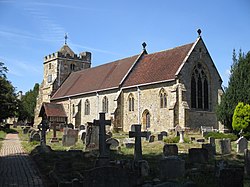Newick
| Newick | |
| Sussex | |
|---|---|
 St. Mary's Church | |
| Location | |
| Grid reference: | TQ415215 |
| Location: | 50°58’48"N, 0°1’12"E |
| Data | |
| Population: | 2,457 (2011) |
| Post town: | Lewes |
| Postcode: | BN8 |
| Dialling code: | 01825 |
| Local Government | |
| Council: | Lewes |
| Parliamentary constituency: |
Lewes |
Newick is a village in Sussex, on the A272 road six miles east of Haywards Heath. It is to be found to the east of the River Ouse. To the north and east is Fletching, to the south is Barcombe and to its west is Chailey.
The village has three pubs, The Crown Inn, The Royal Oak and The Bull Inn, one restaurant (Newick Tandoori), a butcher, a baker, a pharmacy, as well as a number of other businesses. There is also a primary school, a health centre, a village hall known originally as the 'Derek Hall', and a post office.
Churches
The parish church, St. Mary's, dates mainly from the Victorian era, but still has a Norman window. The church stands in isolation to the south of the main village, testament to the time when (until recently) Newick was a scattered village.
The stone oof the church is likely to have been quarried from the sand rock down near Founthill. Parts of the nave are 11th century, the chancel is 13th century, the porch is 14th century, and the tower is 15th century. The churchyard has largely been left and a lot of archaic vegetation still exists including green winged orchid, ox-eye daisy, cuckoo flower and meadow fungi.[1]
Also here was a Strict Baptist chapel, the Zion Chapel: this was built in 1834 but converted into flats in 2001.
Newick Evangelical Free Church, originally a mission hall, opened in 1892.[2]
History
Newick was a dispersed settlement until the Second World War, when many more houses were built around Newick Green (TQ418213). Its mediæval church still stands in isolation to the south.
In the 16th century much of Newick was common land and animals were grazed by locals. The commons were part of the giant Chailey Commons complex. Newick retained its western commons until the middle of the 17th century, when Roeheath and Cinder Commons were almost all enclosed, however Little Roeheath (more a green than a common) still survives.
Society and sport
Like many other Sussex villages, Newick holds an annual Bonfire Night celebration on the Saturday before Lewes Bonfire Night. Many of the local bonfire societies join the procession.
- Amateur dramatics:
- Newick Amateur Dramatic Society
- Newick Youth Theatre
Newick has a King George's Field in memorial to King George V.
About the village
The land around Newick consists of acidic Hastings Beds, and have much hard sandstone, including sandy exposures at Founthill, south of Newick (TQ421200).
The land is very fertile and big Wealden farms, such as the Newick and Sutton Hall Estate, have large arable fields in the area and much of the woodland and hedgerows are now gone. There are still woods around Newick, but they are not as big the Wealden Clay woods in the neighbouring parishes. The area in the south of the parish has several chalybeate springs.
Along the north side verge of the A272 (TQ424213), west of Goldbridge, is famous for its purple-red betony display in July. Fifty herb species were counted here in one short visit in 2014. In 2021 this verge was very derelict and in danger of losing all its botanical display. The area in the south of the parish has several chalybeate springs.
Outside links
| ("Wikimedia Commons" has material about Newick) |
References
- ↑ Bangs, David (2018). Land of the Brighton line : a field guide to the Middle Sussex and South East Surrey Weald. [Brighton]. ISBN 978-0-9548638-2-1. OCLC 1247849975. https://www.worldcat.org/oclc/1247849975.
- ↑ Lindsey, Joyce (1983). Newick: The Story of a Sussex Village c. 900–1950. Newick: Newick Parish Council. p. 36.